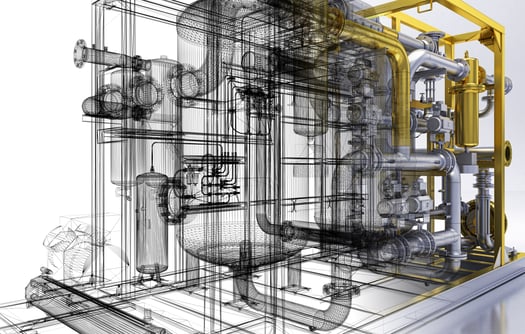Building Information Modeling (BIM) Services
At the heart of BIM is this core functionality—detecting MEP building systems that are interfering with one another to reduce rework, and increase time-saving and cost-effective construction measures.
Get updated on real-time changes and communicate effectively with all project stakeholders from on-site to off-site locations through BIM’s cloud computing and big data.
Invest in BIM’s continuous disruptive growth so you can recoup maximum payback not only in terms of profit, but also on accelerated building handover and quality standards.

As any specialists in the Architecture, Engineering and Construction (AEC) industry might already know, Building Information Modeling (BIM, for short) is slowly taking over and disrupting the industry with an innovative process clearly aim for focused collaboration on the built working environment. Take note of this word: process.
At Nearby EngineersNew York Engineers, we draw you the fine line of distinction between a software and a process—where BIM clearly speaks from the latter option as its core functionality.
By definition, BIM is an intelligent 3D model-based information modeling process generating all physical and functional components into digital representations, all related to a building project life cycle of planning, design, construction and operation. In all its totalities, BIM gives architects, engineers, contractors and everyone involved in building construction sector effective insight patterns to efficiently manage the building project in its schedule, quality and cost tolerances.
In a few words, BIM redefines the conventional methods of AEC industry. At Nearby EngineersNew York Engineers, we lead the forefront in this innovation.
Although the technology has been around for decade, BIM has only seen the light of the day currently with industry players slowly making the transition from old-school 2D CAD to advanced 3D modeling.
From architectural to engineering disciplines and any other professions in between, we give you a list of the top applications of BIM in the AEC industry:
Architects and designers are the pioneers who spearhead this revolutionary change in the industry, mostly since they were the first users who reap the countless benefits of BIM. Leading from this experience and their core function as the mastermind of your building projects, it is only rightly fitting that BIM is up on their arsenal for design optimization, visualization and stakeholder collaboration. Now, architects have an answer for the fluctuating needs of the client: BIM.
Leave the structural components such as columns, beams and slabs to be designed and detailed by an expert civil engineer. As modern codes demand for more stringent standards on structural integrity, civil engineers utilize BIM to minimize errors from design to detailing and finally, fabrication. It's no wonder why parametric building structures are now the norm today.
Construction can be quite the tedious process especially when viewed from the disciplines of project management and construction management. All complex things considered such as site logistics, safety planning, work orders and information flow from the architects and contractors, project managers and construction managers use BIM as a medium for bridging all informational gaps from the stakeholders—thereby effectively meeting at one end for informed decision-making on your building's progress.
Exciting times for the MEP industry as BIM sits right at the top of our toolbox for efficient productivity. Our specialized engineers start by designing your building systems on mechanical, electrical and plumbing—where BIM's core function of clash detection and risk mitigation effectively reduces rework from manufacturing down to on-site systems installation. Get your building systems unified with the time-saving and cost-effective BIM.
The role of BIM in your project's life cycle do not stop after the contractor's turnover to the building owner. With BIM-generated data in place, you can use this smart feature to facilitate the operations and maintenance (O&M) of your building structure. Through cloud computing and big data, you get a bird's eye view of all your building components and track spaces for improvement, routine inspections and proactive risk reversal. Consequently, BIM yields you higher margins and returns for your business down the line.
For every trade, BIM arms you with curated answers. Easy to see now how this specialist, but multi-disciplinary process, paves the way in redefining the architecture, engineering and construction (AEC) landscape.
Wherever you are in the building and construction spectrum, industry specialists can attest to all the top-rated benefits you can recoup from BIM.
From architects, to contractors and engineers alike—here’s where Nearby Engineers New York Engineers give the nod:
BIM certainly gets your leg up in the AEC industry, since all these all-in-one benefits are impossible to be found on any outdated software and processes. Our engineers know at the outset that the strongest suit of BIM lies in its intelligence, but this smart functionality is nothing without experts driving it to its full capacity. To reap these multi-layered benefits from BIM, we recognize early on that we need to combine three elements for success: takes drive, innovation and expertise.
At Nearby EngineersNew York Engineers, we don’t think outside of the box. We believe there is no box.

In a layperson’s eyes, BIM and Revit is all one and the same. Let’s clear that misconception right now. BIM refers to the process itself, while Revit is the toolset for BIM. How does Revit outperform its software counterparts in the industry?
It all starts with how Revit is specifically geared towards custom functionalities for all the sectors in the AEC industry. Case in point, Revit MEP showcases some of the most avant-garde BIM functions in the MEP engineering industry.
Our team of MEP engineers enumerates some of its notable features:
Back to the basics of it all, building systems are one of the critical components of your building structure. And as such, specialized engineering disciplines cater specifically to the complex requirements and needs of the project. Our role as specialists in these departments is to provide custom engineering solutions, and this is where Nearby Engineers New York Engineers excel.
There’s no such thing as a standard design for any building project. Each structure is unique, and one that lists our engineering expertise as a prerequisite and ingredient for success. Standard codes and principles on mechanical, electrical and plumbing engineering all form the baseline metrics where experts can take reference from. However, plans and specifications all require our tailored engineering input, and these customized solutions can be streamlined and facilitated for efficiency through BIM’s digital intervention.
Our specialized engineers drill you in on BIM application for these MEP basics:
BIM, per se, has turned into an advanced technological development, and one that’s noteworthy of its merits in the AEC industry. However, this is not the end-all and be-all for this intelligent model-based informational tool. BIM continues to grow in scalable solutions—often defying the conventional, then transforming the innovation from unfamiliar to mainstream.
In the next two sections, we give you a clue on how Nearby Engineers New York Engineers utilize the progressive growth of BIM. At Nearby EngineersNew York Engineers, we turn impossible to possible.
If you think BIM ends with three-dimensional realm, you’re wrong. This 3D model-based informational tool adds one more to its equation, and goes beyond by adding the attribute of time. In simple words, 4D BIM is essentially 3D BIM integrated with visual scheduling functionalities.
Our MEP engineers know it’s hard enough to keep track of the construction schedule, especially with an accelerated timeline. Planning is still an integral part in construction management, but 4D BIM renders it possible to visualize your construction schedule along with all information generated from the design, construction to operational phases. This allows us to identify gaps for improvement and analysis, since construction sequence can be visualized from here on out.
As engineers working on all types of large-scale complex projects, construction sequence is a critical element that can make or break the success of your building project. MEP building systems are designed and engineered, then handed over to manufacturing for fabrication. Afterwards, systems installation comes in where efficient planning of construction sequence proves to be a critical turning point. But case in point, there’s a direct handover of responsibility matrix from structural engineering as MEP follows sequentially or simultaneously from the critical path management.
Here are all the essential milestones Nearby Engineers New York Engineers consider in delivering 4D BIM solutions for MEP construction sequence:
No evidence that BIM is stopping soon as 4D BIM amps up its dimensional functions through cost integration. Before you come to the conclusion that 5D BIM completely eliminates the role of quantity surveyors, we’ll put a stop right there. Instead of eradication, 5D BIM helps in facilitating the commercial expertise of quantity surveyors, cost estimators and team engineers who perform quantity take-offs. Investing in 5D BIM for your building project means that MEP engineering consultants can extrapolate data directly from a smart information-based software on cost constraints instead of performing time-consuming manual construction cost estimation.
Think how powerful 5D BIM is as it all accounts on construction cost estimation and visual scheduling in as early as pre-design phase to operations phase. Schedule and cost constraints are incorporated right into the building information model—helping project team members coordinate and track quality progress on the basis of your project timeline and budget.
At Nearby EngineersNew York Engineers, we recognize that any deficiencies on time, quality and cost factors can pose blunders on your project completion. We create a unified engineering solution for you through 5D BIM.
BIM is shaking up the AEC industry, and there’s no question that this growth will fuel up even more as 6D BIM is already in the works. We move parallel with innovation, and our specialized MEP engineers go to uncharted territories to challenge the status quo in the industry. We go above and beyond to move past the conventional limits and outperform not only our competitors, but also even our own norms. Reinventing the wheel takes risks, and so far, the benefits heavily outweigh the risks.
At Nearby EngineersNew York Engineers, BIM is the now, and the future. Our goal as expert and experienced engineers is to provide a curated BIM solution for your MEP building systems, so you can leverage and optimize your building for success. Learn how we stay on top by browsing our BIM-related projects with some of the top-tiered local and international project stakeholders.